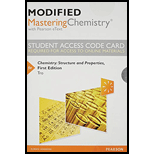
Concept explainers
What are the correct coefficients (reading from left to right) when the chemical equation is balanced?
_PCI3(/) + _H2O(/) → _H3PO3(aq) + _HCl(aq)
1, 3,2,1
1: 2, 1, 1
3, 6, 1,9
1: 3, 1, 3
Interpretation: To find out the correct coefficients when the chemical equation is balanced.
Concept introduction:
In chemistry, the coefficient is the number present in front of the chemical formula in a chemical equation.
Correct answer: The correct answer is option (d)
Explanation of Solution
Reason for the correct answer: The unbalanced equation:
To balance O atoms place the coefficients
To balance Cl atoms place the coefficients
This is the balanced equation because
The correct coefficients from left to right in the balanced equation will be
Reason for incorrect answer: Option (a) coefficient
Option (b) coefficient
Option (c) coefficient
Thus, option (d) is found to be correct answer and options (a), (b) and (c) found to be wrong answers.
Want to see more full solutions like this?
Chapter 8 Solutions
Modified Mastering Chemistry with Pearson eText -- Standalone Access Card -- for Chemistry: Structure and Properties
- The final step in the manufacture of platinum metal (for use in automotive catalytic converters and other products) is the reaction 3 (NH4)2PtCl6(s) 3 Pt(s) + 2 NH4Cl(s) + 2 N2(g) + 16 HCl(g) Complete this table of reaction quantities for the reaction of 12.35 g (NH4)2PtCl6.arrow_forwardDisulfur dichloride, S2Cl2, is used to vulcanize rubber. It can be made by treating molten sulfur with gaseous chlorine. S8() + 4 Cl2(g) 4 S2Cl2(g) Complete this table of reaction quantities for the production of 103.5 g S2Cl2.arrow_forwardThe formation of water-Insoluble silver chloride is useful in the analysis of chloride-containing substances. Consider the following unbalanced equation: BaCl2(aq) + AgNO3(aq) AgCI(s) + Ba(NO3)2(aq) (a) Write the balanced equation. (b) What mass of AgNO3, in grams, is required for complete reaction with 0.156 g of BaCI2? What mass of AgCI is produced?arrow_forward
- 3.94 Calcium carbonate (limestone, CaCO3) dissolves in hydrochloric acid, producing water and carbon dioxide. An unbalanced net ionic equation for this reaction is given below. Balance it. CaCO3(s)+H3O+(aq)H2O(l)+CO2(g)+Ca2+(aq)arrow_forwardBalance each of the following equations, and then write the net ionic equation. Show states for all reactants and products (s, . g, aq). (a) the reaction of sodium hydroxide and iron(II) chloride to give iron(II) hydroxide and sodium chloride (b) the reaction of barium chloride with sodium carbonate to give barium carbonate and sodium chloride (c) the reaction of ammonia with phosphoric acidarrow_forwardChlorine gas was first prepared in 1774 by C. W. Scheele by oxidizing sodium chloride with manganese(IV) oxide. The reaction is NaCl(aq) + H2SO4(aq) + MnO2(s) Na2SO4(aq) + MnCl2(aq) + H2O(l) + Cl2 (g) Balance this equation.arrow_forward
- 3.92 Many chemical reactions take place in the catalytic con- verter of a car. In one of these reactions, nitric oxide (NO) reacts with ammonia (NH3) to give nitrogen (N2) and water. Write a balanced equation for this reaction.arrow_forwardBalance the following equations representing combustion reactions: a. b. c. C12H22O11 (s) + O2(g) CO2 (g) + H2O (g) d. Fe(s) + O2(g) Fe2O3(s) e. FeO(s) + O2(g) Fe2O3(s)arrow_forwardIn a common experiment in the general chemistry laboratory, magnesium metal is heated in air to produce MgO. MgO is a white solid, but in these experiments it often looks gray, due to small amounts of Mg3N2, a compound formed as some of the magnesium reacts with nitrogen. Write a balanced equation for each reaction.arrow_forward
- An unknown solid acid is either citric acid or tartaric acid. To determine which acid you have, you titrate a sample of the solid with aqueous NaOH and from this determine the molar mass of the unknown acid. The appropriate equations are as follows. Citric acid: H3C6H5O7(aq) + 3 NaOH(aq) 3 H2O(l) + Na3C6H5O7(aq) Tartaric acid: H2C4H4O6(aq)+ 2 NaOH(aq) 2 H2O(l) + Na2C4H4O6(aq) A 0.956-g sample requires 29.1 mL of 0.513 M NaOH to consume the acid completely. What is The unknown acid?arrow_forwardHigh cost and limited availability of a reactant often dictate which reactant is limiting in a particular process. Identify the limiting reactant when the reactions below are run, and come up with a reason to support your decision. a. Burning charcoal on a grill: C(s)+O2(g)CO2(g) b. Burning a chunk of Mg in water: Mg(s)+2H2O(l)Mg(OH)2(aq)+H2(g) c. The Haber process of ammonia production: 3H2(g)+N2(g)2NH3(g)arrow_forward(a) Butane gas, C4H10, can burn completely in air [use O2(g) as the other reactant] to give carbon dioxide gas and water vapor. Write a balanced equation for this combustion reaction. (b) Write a balanced chemical equation for the complete combustion of C3H7BO3, a gasoline additive. The products of combustion are CO2(g), H2O(g), and B2O3(s).arrow_forward
 Chemistry & Chemical ReactivityChemistryISBN:9781337399074Author:John C. Kotz, Paul M. Treichel, John Townsend, David TreichelPublisher:Cengage Learning
Chemistry & Chemical ReactivityChemistryISBN:9781337399074Author:John C. Kotz, Paul M. Treichel, John Townsend, David TreichelPublisher:Cengage Learning Chemistry & Chemical ReactivityChemistryISBN:9781133949640Author:John C. Kotz, Paul M. Treichel, John Townsend, David TreichelPublisher:Cengage Learning
Chemistry & Chemical ReactivityChemistryISBN:9781133949640Author:John C. Kotz, Paul M. Treichel, John Townsend, David TreichelPublisher:Cengage Learning Chemistry for Engineering StudentsChemistryISBN:9781337398909Author:Lawrence S. Brown, Tom HolmePublisher:Cengage Learning
Chemistry for Engineering StudentsChemistryISBN:9781337398909Author:Lawrence S. Brown, Tom HolmePublisher:Cengage Learning Chemistry: The Molecular ScienceChemistryISBN:9781285199047Author:John W. Moore, Conrad L. StanitskiPublisher:Cengage Learning
Chemistry: The Molecular ScienceChemistryISBN:9781285199047Author:John W. Moore, Conrad L. StanitskiPublisher:Cengage Learning ChemistryChemistryISBN:9781305957404Author:Steven S. Zumdahl, Susan A. Zumdahl, Donald J. DeCostePublisher:Cengage Learning
ChemistryChemistryISBN:9781305957404Author:Steven S. Zumdahl, Susan A. Zumdahl, Donald J. DeCostePublisher:Cengage Learning Introductory Chemistry: A FoundationChemistryISBN:9781285199030Author:Steven S. Zumdahl, Donald J. DeCostePublisher:Cengage Learning
Introductory Chemistry: A FoundationChemistryISBN:9781285199030Author:Steven S. Zumdahl, Donald J. DeCostePublisher:Cengage Learning





